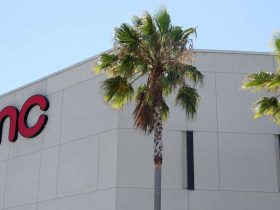The costs of a lengthy auto strike would hit workers hard, and at the wrong time of the year.
Friday morning, the United Auto Workers went on strike at the Detroit-Three auto makers:
General Motors
(ticker: GM),
Ford Motor
(F), and Chrysler parent
Stellantis
(STLA). The tab for the walkout is starting to accumulate. A three-month strike would stretch into early December and might be enough to eliminate most, or all, of annual profit-sharing checks coming from the Detroit-Three auto makers. Profit-sharing risk is another example of the high-stakes game of poker being played by the union and car companies.
Reduced profit-sharing comes from reduced profit. There are differences in formulas used to calculate profit-sharing for the three auto makers, but the sharing plan pays roughly $1,000 to each hourly worker for every $1 billion in North American operating profit generated annually.
Profit-sharing has been a nice boost to compensation for hourly auto workers in recent years. “Our full-time folks saw profit-sharing amounts of about $44,700 [per worker] over the last four years,” says Stellantis COO of North American operations Mark Stewart. Ford says it paid out about $9,000 per worker in 2022 and about $1.5 billion in profit sharing to UAW-represented employees during the past four years. GM paid out $500 million, or between $12,000 and $13,000 per worker last year.
The amounts are significant. The average UAW wage is roughly $30 an hour, or about $60,000 a year based on a 40-hour work week and 50 weeks a year. Profit sharing can easily amount to 15% of gross, pre-tax pay.
How much profit erosion a strike causes is the key question. The 40-day strike against General Motors in 2019 cost the company about $3.6 billion. It still earned $8.4 billion for the full year. At that rate of profit erosion, it might take a 20-week strike to eliminate all profit. Ford is a little less profitable than GM. Its profits could completely dwindle away in about 12 or 13 weeks.
No, or smaller, profit-sharing checks coming early in 2024 are compounded by lower pay. Striking workers get about $500 a week from the UAW strike fund. That’s about $700 a week less than the average hourly wage. A three-month strike could effectively end up costing workers roughly $18,000 in wages over the final months of 2023.
Striking workers are eligible for strike pay. GM and Ford have laid off some workers after the UAW struck against specific facilities. It isn’t clear whether laid-off workers will get strike pay. The UAW didn’t immediately respond to a request for comment.
The layoffs were a direct result of the strike. Ford’s Michigan Assembly complex that makes Rangers and Brocos illustrates the problem. The UAW leadership instructed paint shop and final assembly workers to walk out. That leaves no work for other departments at the plant so Ford told 600 employees not to come in. (The stamping plant is still currently running.) The laid-off workers won’t be eligible for supplementary benefits from Ford and striking workers generally don’t qualify for unemployment benefits in Michigan.
Costs from a strike accumulate rapidly on both sides. There is a lot at stake for auto makers and hourly employees. The best outcome is a deal that both sides can live with and that is reached quickly.
Shares of Ford and GM are both down about 16% over the past two months as labor negotiations heated up. The
S&P 500
is down about 1% over the same span. Stellantis stock is up about 3% over the past two months. Its shares have held up better than shares of the other two auto makers with roots in Detroit.
Write to Al Root at [email protected]
Read the full article here











Leave a Reply